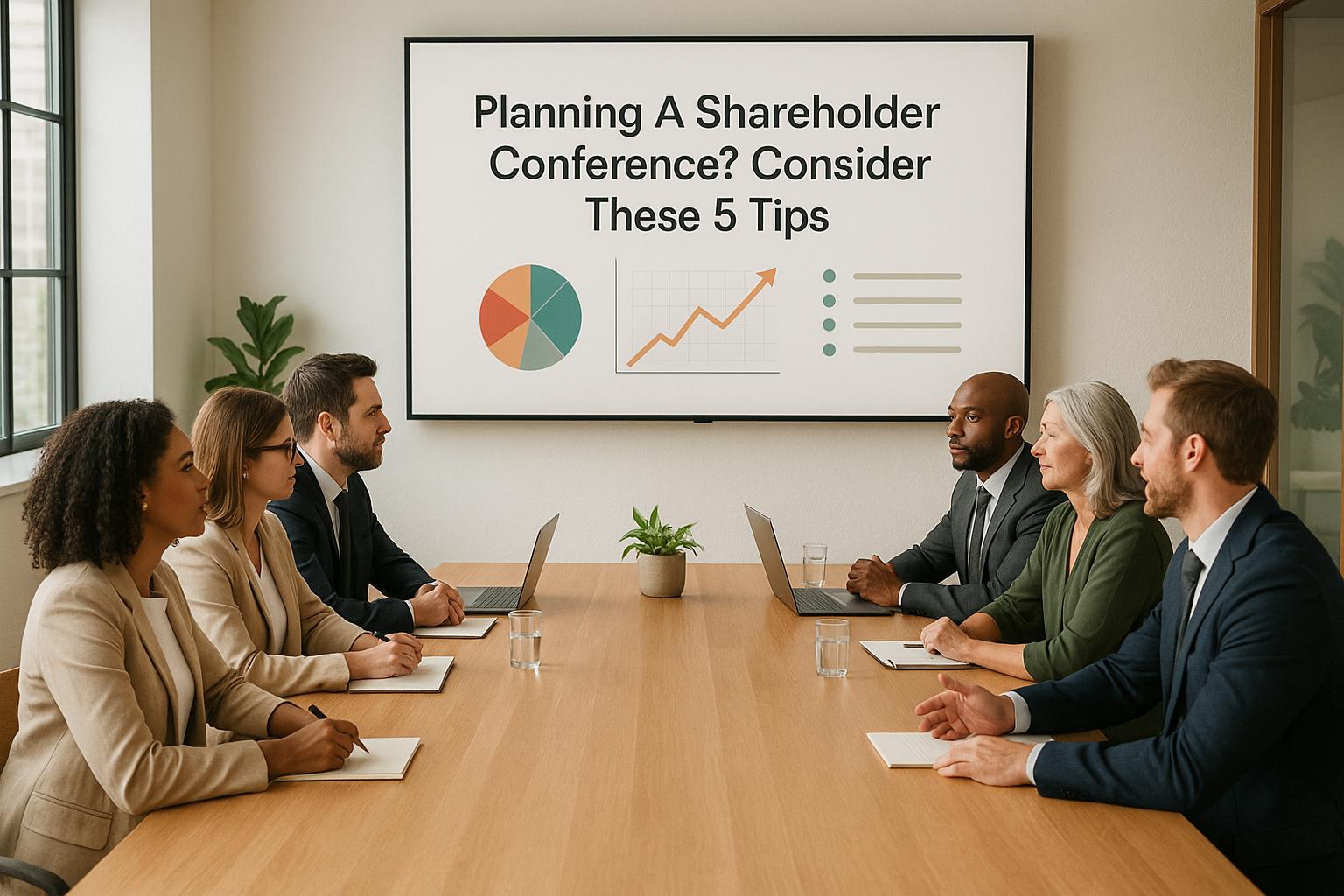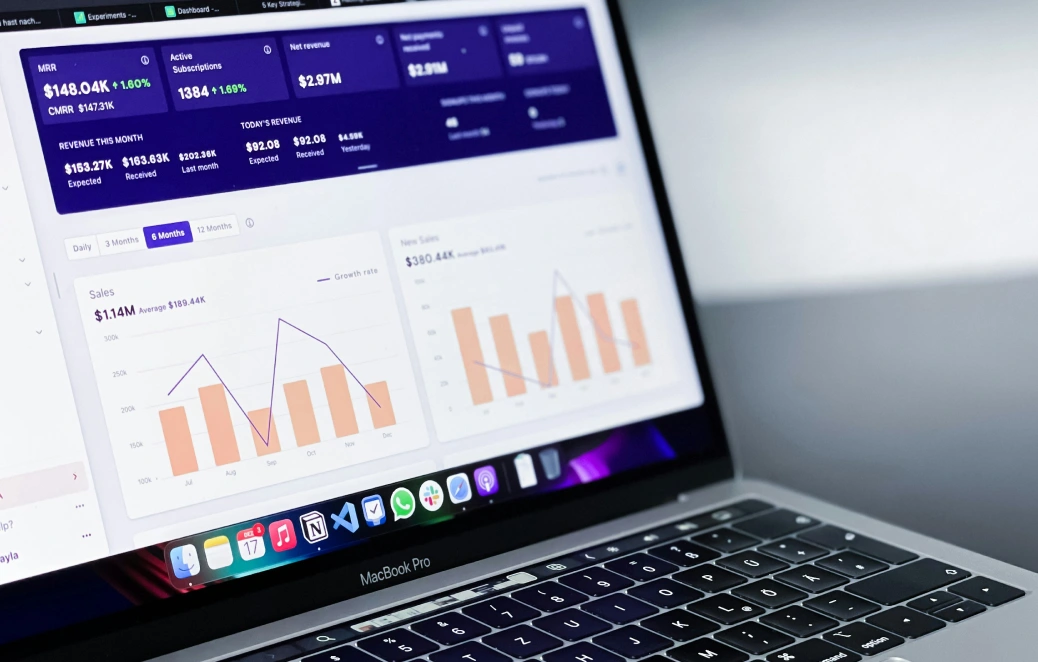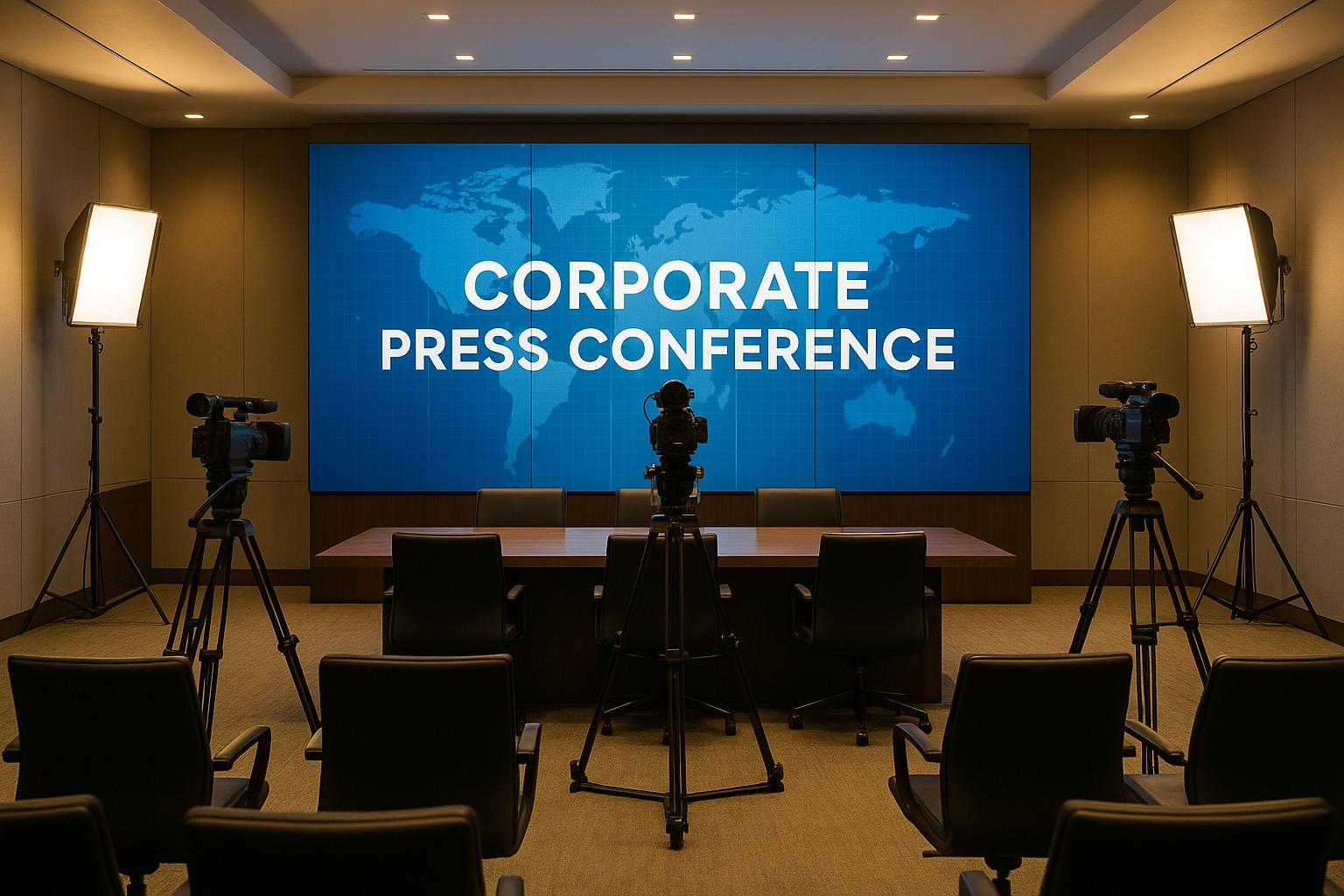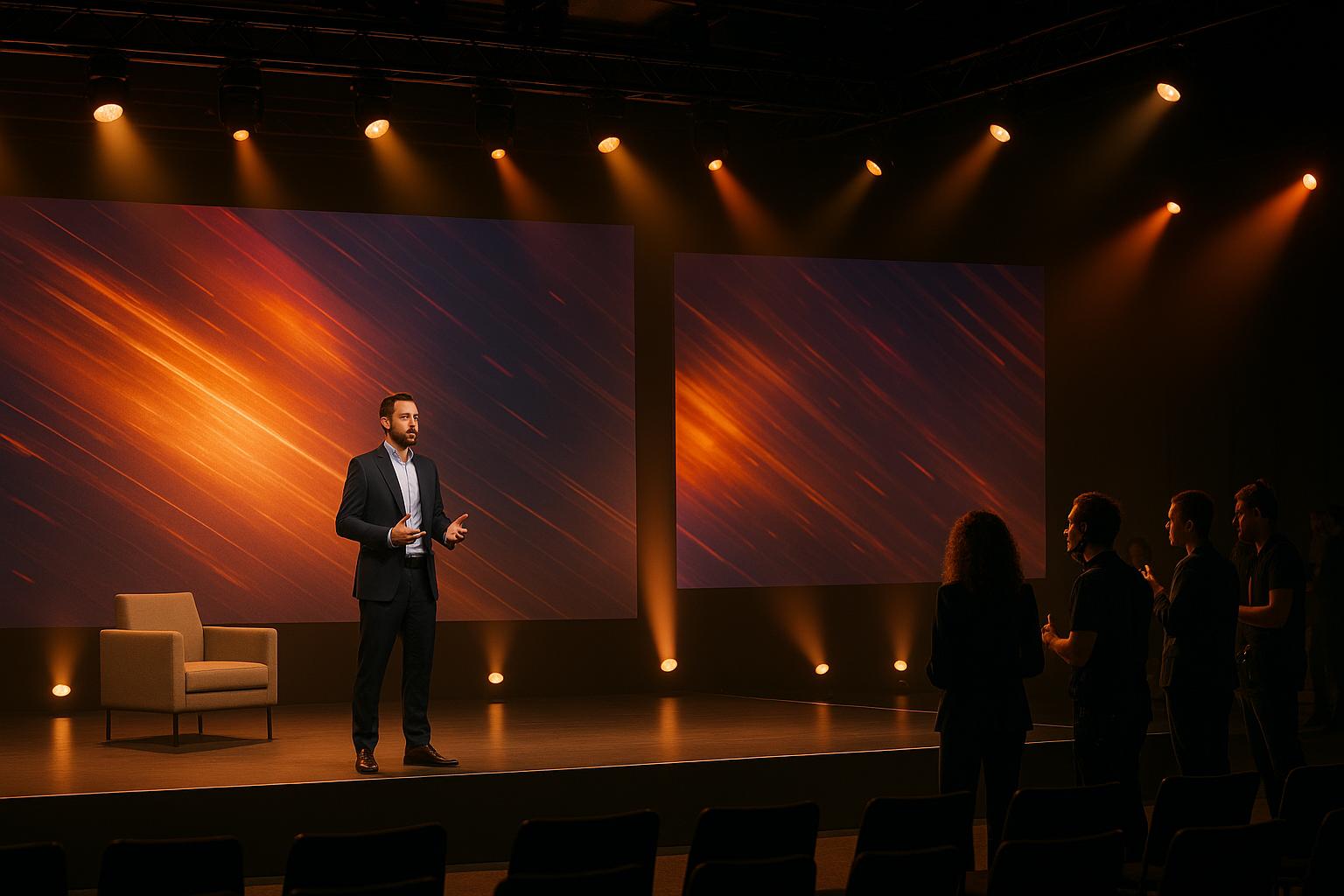Planning A Shareholder Conference? Consider These 5 Tips

Chief Executive Officer

A successful shareholder conference hinges on five critical areas: technology, agendas, logistics, communication, and presentations. Here’s a quick breakdown:
- Audiovisual Technology: Use high-quality equipment like 4K displays, wireless microphones, and reliable live-streaming platforms to ensure flawless delivery for both in-person and virtual audiences.
- Clear Agenda and Pre-Meeting Materials: Share a detailed agenda and relevant documents at least 14 days in advance to help attendees prepare and participate meaningfully.
- Logistics: Choose an accessible venue with strong internet support, streamline registration, and prepare a detailed checklist to avoid last-minute issues.
- Stakeholder Communication: Send professional invites 30 days ahead, provide updates, and encourage real-time engagement through Q&A and polling tools.
- Engaging Presentations: Use polished visuals, interactive elements, and storytelling to keep shareholders focused and invested.
When these elements come together, you’re set to deliver a professional, impactful event that strengthens investor confidence.
Why Is A Well-planned Annual General Meeting (AGM) Important? - Event Management Pro Tips
Tip 1: Choose the Right Audiovisual Technology
The audiovisual setup you choose for your shareholder conference can make or break the impression you leave on investors. Clear sound, sharp visuals, and glitch-free presentations are key to showcasing your company’s professionalism. On the flip side, poor audio quality, blurry screens, or technical hiccups can distract stakeholders and detract from your message. It’s all about ensuring your AV setup keeps the focus on your content - not the technology.
Today’s shareholder events demand advanced tech solutions that go well beyond basic microphones and projectors. Whether attendees are seated in the room or tuning in remotely, they expect a smooth, high-quality experience. To meet these expectations, your AV strategy needs to cater to both in-person and virtual audiences without compromising on quality.
Invest in High-Quality Equipment
Start with high-definition displays. Whether it’s a 4K monitor or an LED wall, your visuals should remain crisp and easy to read for everyone in the room. Outdated screens not only look unprofessional but can also make detailed financial charts hard to follow.
Wireless microphone systems are another must. They free presenters from being stuck at the podium and eliminate the hassle of tangled cords. Look for professional-grade wireless systems with backup frequencies to avoid interference. Lavalier microphones work well for executives who need to move around, while handheld wireless mics are ideal for audience Q&A sessions.
For remote attendees, integrated live streaming platforms are essential. Choose a system that supports multiple camera angles and allows seamless transitions between slides and speaker views. Aim for 1080p resolution with minimal lag, ensuring that virtual participants enjoy the same quality as those attending in person. This is particularly important for presenting financial data and key visuals.
Lighting also plays a big role. LED lighting panels with adjustable color temperatures can help presenters look polished and professional, avoiding unflattering shadows during important moments.
Adapt for Hybrid Formats
If your event includes both in-person and virtual elements, you’ll need to think beyond individual equipment. Hybrid integration requires a cohesive approach to ensure everything works together smoothly. This includes tools like live polling systems, digital Q&A platforms, and chat features that keep remote attendees engaged.
Audio mixing is crucial when juggling questions from both in-person and online participants. A skilled sound engineer can blend room audio, wireless microphones, and digital audio feeds seamlessly, avoiding feedback or delays that disrupt the conversation.
Camera setup and switching should go beyond static shots of the stage. Include close-ups of speakers, wide shots of the room, and audience reaction shots to give remote viewers a feel for the event’s energy. Plan for at least three camera angles to cover all the action.
Don’t forget about bandwidth management. A stable internet connection is non-negotiable, especially with a large virtual audience. Test your network capacity well ahead of time and have backup options ready. A frozen video feed during a critical financial update can quickly erode investor confidence.
Partner with a Reliable Provider
When the stakes are high, working with an experienced AV provider can take a lot of pressure off your team. For example, Corporate Optics offers Emmy Award-winning expertise in shareholder event production. Their team understands the unique demands of corporate communications and ensures your technology choices align with investor expectations, helping you deliver a polished and professional experience.
Their services include end-to-end technical support, from equipment setup to on-site troubleshooting during the event. With their technicians handling the AV systems, your team can focus on delivering content and engaging with stakeholders instead of worrying about technical issues.
They also provide post-event analytics, giving you insights into engagement levels and technical performance. These reports can highlight what resonated with your audience and what could be improved for future events.
Finally, contingency planning is a key benefit of working with a professional provider. They come prepared with backup equipment and solutions for common technical problems, ensuring your event stays on track even if something goes wrong. Their experience with high-stakes events means they know how to resolve issues quickly, protecting your schedule and reputation.
Tip 2: Create a Clear Agenda and Pre-Meeting Materials
A well-organized agenda and thoughtfully prepared pre-meeting materials play a key role in setting the stage for a productive conference. Shareholders expect professionalism from the moment they’re invited, and a clear agenda helps establish that by outlining the topics and decisions to be addressed. When attendees have all the necessary details in advance, they can come prepared with insightful questions and actively participate in discussions. Combined with reliable audiovisual systems, a precise agenda becomes an essential tool for success.
Set Clear Goals
Before drafting your agenda, define the specific objectives of the conference. Are you seeking approval for a major acquisition? Presenting annual financial results? Introducing new board members? Each goal should have its own agenda item with an allotted time.
Prioritize your objectives. Start with the most critical items that require shareholder votes, then move on to updates and, finally, strategic discussions about the future. Allocate time based on the complexity of each topic - some may need more attention than others. Striking the right balance ensures that high-priority decisions are addressed while leaving room for updates and forward-looking conversations.
Send Pre-Meeting Materials Early
Timing is everything when it comes to distributing materials. Shareholders should receive a formal notice of the meeting at least 10 days beforehand, and pre-meeting materials should be sent no later than 14 days prior to the event. This allows attendees enough time to review financial documents, research agenda topics, and prepare thoughtful questions.
Your pre-meeting package should include:
- The official meeting notice
- A detailed agenda with estimated times
- Financial statements
- Proxy statements for voting items
- Clear attendance and participation instructions
For hybrid meetings, include step-by-step instructions for joining virtually, voting electronically, and submitting questions online.
Cater to different shareholder groups. Registered shareholders and beneficial holders often have distinct voting procedures. Provide tailored guidance for each group, and include contact details for shareholder services to address any questions in advance.
Mix Content with Engagement
A great agenda combines information sharing with interactive elements to keep participants engaged. Long, uninterrupted presentations can cause attention to wane, especially for virtual attendees. Break up the flow with interactive sessions like Q&A, polls, or short discussions.
Schedule regular breaks to help maintain focus, and leave some flexibility in the agenda to allow for deeper discussions on topics that spark high interest.
Set clear guidelines for questions. Let shareholders know how and when they can ask questions, whether during designated Q&A periods or throughout the meeting. Be upfront about any time limits or submission requirements. Choose an approach that fits both your content and the size of your audience to ensure smooth communication and active participation.
Tip 3: Handle Hybrid and In-Person Event Logistics
Running a shareholder conference involves a lot of moving parts, whether you're hosting attendees in person, online, or both. Solid event logistics are the backbone of a smooth and professional experience. When done well, they create an environment where shareholders can engage meaningfully. But if things go wrong, even the best content can lose its impact.
This groundwork starts with selecting the right venue.
Pick the Right Venue
The venue you choose can make or break your event, especially when you're juggling both in-person and virtual participants. Accessibility should be a top priority. Ensure the location meets ADA standards and is easy to reach, offering convenient parking or public transportation options. For hybrid events, a strong internet connection is non-negotiable - your venue must support high-quality live streaming without interruptions.
Make sure there's enough space for everyone. The venue should comfortably accommodate your attendees and include areas for registration, networking, and any necessary tech setups. If you're streaming the event, set aside extra space for your technical team and their equipment.
Check the venue's audiovisual (AV) capabilities, too. Built-in systems that support live streaming and recording can save time and money, but always test them in advance to ensure everything works as expected. Don’t overlook the acoustics - venues with carpeting, curtains, or acoustic panels usually provide better sound quality than those with hard surfaces and high ceilings, which can create echoes.
Set Up Efficient Registration and Staffing
First impressions matter, and a smooth registration process can set the right tone for your conference. Create separate check-in processes for different shareholder types and virtual participants to keep things organized and efficient.
Equip your registration team with digital tools like tablets or laptops connected to your attendee database. This allows them to quickly verify shareholder information and distribute materials. Always have a backup plan, such as printed lists and manual check-in options, in case technology fails.
Clearly define staff roles to cover all bases. Assign specific team members to handle technical support, answer shareholder inquiries, and manage general event coordination. Virtual attendees often need real-time assistance with login issues or voting procedures, so have at least one staff member dedicated to supporting remote participants.
For technical issues, designate a separate team to handle glitches. Make sure your staff is well-trained on the hybrid setup and familiar with shareholder voting and question submission processes. This ensures they can assist attendees effectively and escalate complex issues when needed.
Use a Logistics Checklist
A detailed checklist is your best friend when preparing for a shareholder conference. Start building it early to cover everything from booking the venue to testing equipment and preparing materials.
Your checklist should address both legal and operational requirements. For example, ensure your meeting notice and proxy materials comply with SEC regulations and state corporate laws. Test voting procedures for both in-person and virtual participants to confirm your platform can handle the expected traffic.
Include technical rehearsals in your checklist to identify and fix potential issues before the event. For remote attendees, plan for login credential distribution, provide technical support contact details, and set up backup communication channels. Send out clear connection instructions well in advance to make sure virtual participants are ready to join.
Don't forget to include items related to vendor coordination, regulatory compliance, and venue logistics. Schedule a full run-through of the event to verify that every detail is accounted for.
Finally, think about post-event tasks. Arrange for equipment breakdown, collect materials, and handle cleanup. If you're recording the event, make sure you’ve planned for storage and editing so the session is ready for later distribution. These steps ensure your event wraps up as smoothly as it begins.
sbb-itb-ae35a94
Tip 4: Maintain Clear Stakeholder Communication
How you communicate with your shareholders can make or break the success of your conference. Clear and consistent messaging - before, during, and after the event - ensures that attendees feel informed, valued, and confident in your company’s direction. When shareholders trust that they’re being kept in the loop, they are more likely to stay engaged and supportive.
Send Professional Invites and Updates
Your first point of contact with shareholders sets the stage for the entire event. A polished and professional invitation, sent well in advance, signals that you take their time and participation seriously. Aim to send formal invitations 30 days ahead of the event, including all the key details: date, time (in 12-hour format with AM/PM), venue address, and clear instructions for attending in person or virtually.
Use a branded email template to maintain consistency and professionalism. Attach important materials such as the conference agenda, proxy documents, and any financial reports shareholders should review beforehand. If your company is publicly traded, ensure these materials comply with SEC disclosure rules and include any necessary legal disclaimers.
Follow up with reminders two weeks before the event and again 48 hours beforehand. These updates should include any logistical changes, like parking arrangements, security protocols, or updates to the agenda. To streamline access to resources, consider creating a dedicated conference webpage where shareholders can find all event materials, submit questions in advance, and access technical support. This centralized approach reduces confusion and reinforces your commitment to being organized and transparent.
Enable Real-Time Interaction
Clear pre-event communication is just the beginning. Shareholders expect opportunities for active engagement during the conference itself. Incorporating interactive elements can transform a one-sided presentation into a dynamic, two-way conversation.
Use tools like live Q&A sessions and real-time polls to keep participants engaged. Digital platforms allow shareholders to submit questions anonymously, encouraging more candid discussions about sensitive topics. Instead of waiting until the end of the event, schedule time for questions throughout the agenda to maintain energy and focus.
Real-time polling is another valuable tool that helps you gauge shareholder sentiment on critical issues or decisions. These polls not only provide immediate feedback but also act as natural transitions between topics, breaking up longer sessions and re-energizing attendees.
For virtual participants, set up dedicated technical support channels to address issues like login problems, sound glitches, or voting instructions. Having a team ready to respond quickly ensures minor tech hiccups don’t derail the experience. For more complex topics, consider offering breakout sessions or smaller group discussions. These provide shareholders with the chance to explore specific areas of interest in greater depth and receive more personalized attention.
Get Ready for Expected Questions
Preparation is key when it comes to handling shareholder inquiries. Anticipate the types of questions you’re likely to receive and craft thoughtful, transparent responses that address concerns head-on.
Start by creating a detailed FAQ covering common topics such as financial performance, strategic goals, market trends, and governance practices. Share this FAQ with your executive team and board members to ensure consistent messaging. Be sure to back up your answers with data, timelines, and concrete examples.
Assign subject matter experts to address specific areas. Whether it’s a technical question or a financial deep dive, having the right person ready to respond demonstrates your team’s expertise and builds credibility. Brief these experts on the event’s format so they can effectively engage with both in-person and virtual audiences.
For sensitive or challenging questions, practice delivering responses that acknowledge shareholder concerns while highlighting positive developments or corrective actions. Avoid corporate jargon - shareholders value honest, straightforward answers. If you don’t have an immediate answer, commit to following up with a clear timeline rather than making vague promises.
Establish a post-conference follow-up process for questions requiring additional research. Send written responses within five business days and make them available to all shareholders, not just the individuals who asked the questions. This approach ensures fairness and keeps everyone informed.
Finally, train your team to recognize when a question needs to be escalated to senior leadership. Some inquiries may require responses from the CEO or CFO, while others can be handled by department heads or investor relations staff. Clear escalation protocols prevent delays and show shareholders that their concerns are being taken seriously. Timely, thoughtful follow-ups go a long way in reinforcing transparency and maintaining investor confidence.
Tip 5: Design Engaging Presentations and Interactive Sessions
The design of your presentation plays a huge role in keeping shareholders engaged while reinforcing your company’s value. A strong presentation doesn’t just share information - it tells a story that connects with investors and highlights your company’s growth potential. By combining strategic storytelling with clear, data-backed arguments, you can ensure your message leaves a lasting impression.
Use Professional Visual Aids
The right visuals can make or break a presentation. A polished design not only looks professional but also builds credibility. Stick to consistent branding by using your company’s colors, fonts, and logos on every slide. This creates a cohesive look that reinforces your corporate identity.
When presenting data, keep it simple and visually clear. Replace text-heavy slides with clean graphics and charts. For example, instead of listing quarterly revenue figures, use a bar chart to show growth trends over time. Financial data should follow U.S. formatting - use commas for thousands (e.g., 1,000,000) and periods for decimals (e.g., 3.14).
Each slide should focus on one main idea. Use the slide heading to clearly state your point and ensure all content supports that message. Design slides so that even someone glancing at them briefly can understand the takeaway. Aim to cover each slide in under a minute to keep the pace lively.
Make readability a priority by using high contrast colors and simple backgrounds. Choose sans serif fonts in large sizes, avoid italics and underlining, and use bold text for emphasis instead. Avoid all caps, as they can be hard to read. Also, choose color combinations that are accessible for those with color blindness, as this affects about 8% of men and 0.5% of women.
Animations can be tempting but should be used sparingly. Stick to simple transitions that won’t distract or cause technical issues. Static graphics and clean transitions are more reliable and ensure your content looks great across all devices.
Add Interactive Elements
Static presentations can quickly lose their audience. To keep shareholders engaged, make the experience interactive and dynamic, creating opportunities for real-time participation.
"According to our 2023 State of Meetings report, over half of business leaders claimed low engagement was their biggest meeting pain point." – Mentimeter
Start strong with an icebreaker or an eye-catching industry statistic. For example, instead of opening with routine introductions, share a key market insight or highlight a recent challenge your company has overcome. This sets the tone for an engaging session.
Incorporate short Q&A sessions after each major topic to keep the energy up and adjust your messaging based on shareholder feedback. Live polling is another great tool - use it to gauge opinions on strategic decisions or priorities. For instance, you could poll shareholders on how they’d allocate capital or their confidence in entering a new market. Digital polling platforms allow for anonymous responses, encouraging honest feedback.
For smaller groups, consider breakout discussions where attendees can dive deeper into specific topics. Divide participants into smaller teams to brainstorm challenges or opportunities, then have them share their insights with the larger group. This approach works well in hybrid events, where virtual breakout rooms can mirror in-person discussions.
To keep the presentation fresh, mix up your content. Break up financial reports with customer testimonial videos, animated infographics, or quick case studies that showcase product success. This variety caters to different learning preferences and keeps attention levels high.
Use the Right Tools
Engaging visuals and interactive elements are only as effective as the tools you use to deliver them. While PowerPoint remains a reliable option, there are other platforms designed to enhance interactivity and engagement.
For real-time feedback, live polling tools are invaluable. They let you gather audience input instantly, display results on-screen, and even collect anonymous questions. These features go beyond what traditional presentation software offers.
Hybrid events require platforms that cater to both in-person and virtual attendees. Professional webinar tools allow for simultaneous polling, integrated voting systems for shareholder resolutions, and advanced Q&A management. They ensure virtual participants have an equally engaging experience.
Companies like BHP have set a great example by hosting regular online Q&A sessions with leadership, fostering ongoing dialogue with shareholders throughout the year.
Behind the scenes, collaborative platforms are key for preparing presentations. These tools allow teams to review and edit content in real time, ensuring all speakers stay aligned. When multiple contributors are involved, clear version control and approval processes are essential to avoid confusion.
Lastly, choose tools that provide detailed analytics on audience engagement. Metrics like participation rates, popular questions, and polling results can help you identify which topics resonate most. This data is invaluable for refining your approach to future communications.
With 91% of investors prioritizing companies that offer board-level engagement, integrating interactive technology into your shareholder conference isn’t just about making the event better. It also demonstrates your commitment to transparency and open communication, building trust that lasts long after the conference ends.
Conclusion: Key Points for a Successful Shareholder Conference
Pulling off a successful shareholder conference means excelling in five key areas: top-notch audiovisual technology, well-prepared agendas with pre-meeting materials, smooth logistics management, clear communication with stakeholders, and engaging presentations that encourage interaction.
It’s not just about having flawless technology - though that’s essential. A clear, structured agenda paired with comprehensive pre-meeting materials ensures shareholders are informed and ready to engage. When attendees know what to expect and have the necessary details in advance, they can contribute more thoughtfully to discussions and decisions.
Logistics management is another cornerstone. Professional execution of even the smallest details sets the tone for the event, allowing participants to focus on the content rather than being distracted by organizational hiccups.
Communication plays a pivotal role, too. From sending out professional invitations to providing timely updates and enabling real-time interactions, staying connected with stakeholders builds trust. Add to this engaging presentations supported by polished visuals and interactive elements, and you’ve got a recipe for keeping your audience focused and invested in your message.
When these components come together, they create a seamless and impactful event. Companies like Corporate Optics specialize in this kind of end-to-end event production, ensuring every detail aligns with the goal of reinforcing investor confidence. Their expertise in shareholder meeting production and hybrid event management makes them a valuable partner in delivering a polished and professional experience.
FAQs
How can I set up audiovisual technology to ensure a smooth experience for both in-person and virtual attendees at a shareholder conference?
To create a smooth experience for both in-person and virtual attendees, start by investing in the right tools. This includes high-quality microphones, cameras, speakers, and a reliable video conferencing platform. Position cameras thoughtfully so remote participants have a clear view of the room and everyone in it. Choose microphones that evenly capture voices while minimizing background noise to keep the audio crisp and clear.
Before the event, test your setup thoroughly to make sure everything is functioning properly. Regular maintenance, like updating software and checking connections, can help you avoid any technical glitches during the event. Using a simple, easy-to-navigate system will also make it less stressful for your team to manage the event seamlessly.
How can I create an agenda and share pre-meeting materials to boost shareholder engagement?
To improve shareholder engagement, start by preparing a well-structured agenda. Break it into clear sections, assign time slots for each topic, and include the names of presenters. Sharing this agenda at least a month in advance gives participants plenty of time to familiarize themselves with the meeting’s flow.
Additionally, provide pre-meeting materials like financial statements, company updates, and relevant policies about a week before the event. This allows shareholders to review the information, formulate thoughtful questions, and participate more actively. You might also send out a brief survey beforehand to gather feedback on topics shareholders want covered. This approach not only encourages interaction but also ensures the meeting addresses their priorities.
How can I effectively manage logistics to create a smooth experience for both in-person and virtual attendees at a shareholder conference?
To create a seamless experience for both in-person and virtual attendees, start by assembling a dedicated planning team. This group should handle essential tasks like coordinating the venue setup, managing technology, and ensuring clear communication. Regular meetings will help the team stay aligned and adapt to any changes as the event approaches.
Select a venue that’s convenient to access and fits the needs of your event. Test all audiovisual equipment thoroughly, and make sure your technology can handle the demands of both in-person and virtual participation without hiccups. Using event management software can also streamline tasks like registration and attendee interaction, saving time and effort.
Lastly, prepare for the unexpected. Develop contingency plans for potential issues such as power outages, internet interruptions, or staffing shortages. Being ready for these challenges will ensure you can tackle surprises effectively and present a polished, professional event.
Related Blog Posts









